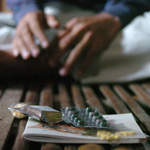



Overall, governments are now tackling AIDS much more actively.
Indeed, within world regions, many countries are building international partnerships to coordinate the fight against HIV/AIDS so as to get as close as possible to offering HIV treatment to all those who need it by 2010.
Most countries now have a national plan to deal with AIDS and a single organization to coordinate efforts, and about half of them also have a plan to measure the progress made. However, systems to put these plans into effect and the involvement from civil society and from people living with HIV are still uneven. More...
Prevention programmes involve a series of services that aim to prevent HIV transmission through sexual intercourse, from mother to child, through injecting drug use, and through blood transfusions.
Such prevention services include for instance access to HIV counselling and testing, prevention education for young people, provision of condoms to those who are sexually active, programmes to reduce HIV-related stigma and discrimination, and treatment of other sexually transmitted diseases.
While in some countries HIV prevention services are much more widely available now than in 2001, they only reach a small minority of those in need, and a number of target groups are not being reached.
Programmes aimed at changing behaviour have succeeded in reducing the frequency of risky sexual behaviours. Countries that have lowered HIV incidence have benefited from the emergence of new sexual behaviour patterns – fewer commercial sex transactions in Cambodia and Thailand, delayed sexual debut in Zimbabwe, increasing emphasis on monogamy in Uganda and an increase in condom use overall.
Most countries, however, have missed the target of ensuring that 90% of young people have access to critical HIV prevention services by 2005. In fact, less than 50% of young people in the 18 countries surveyed were well informed about AIDS prevention and transmission.
The global supply of condoms by the public sector covers less than half the present need and three times more funding is required for this purpose.
More than 340 million people contract a curable sexually transmitted infection each year and women are especially vulnerable. Despite the fact that untreated sexually transmitted infections greatly increase the risk of HIV transmission, diagnosis and treatment of sexually transmitted infections and HIV are not very coordinated.
Though prevention strategies are cost-effective, there are disturbing signs that some countries are reducing their HIV prevention budgets.
Unsafe medical injections and contaminated blood transfusions are still cause for concern, and sound infection control practices should be promoted in health-care settings. More...
A combination of antiretroviral treatments is effective in preventing or delaying AIDS-related illness and death. However, such lifelong therapies are complex and expensive to deliver, which raises concerns regarding access to treatment in resource-limited settings.
In recent years there has been a worldwide revolution in improving access to treatment.
The 2001 Declaration of Commitment on HIV/AIDS embraced equitable access to care and treatment as fundamental to an effective global HIV response.
In 2003, UNAIDS and WHO launched the "3 by 5" initiative which was a global target to provide three million people living with HIV/AIDS in low- and middle-income countries with life-prolonging antiretroviral treatment (ART) by the end of 2005.
In low- and middle- income countries, the number of sites providing antiretroviral drugs increased from roughly 500 in 2004 to more than 5000 by the end of 2005 and, between 2001 and 2005, the number of people on antiretroviral therapy increased from 240 000 to approximately 1.3 million. This major increase still falls short of the “3 by 5” 3 million target.
As a result of recent unprecedented action across the world to increase access to HIV treatment, some 250 000 to 350 000 lives were saved in 2005.
Twenty-one countries met the 2005 target of providing treatment to at least half of those who need it. Globally, however, antiretroviral drugs still reach only one in five of those who need them.
The expansion of treatment access is hindered, because many individuals cannot afford the treatment-related expenses, or live far from treatment centres. In addition, the needs of certain vulnerable populations, such as sex workers, men who have sex with men, injecting drug users, prisoners, and refugees have been inadequately addressed
To expand delivery of antiretroviral drugs in resource-limited settings, WHO recommended simplified and standardized treatment programmes involving first-line treatment therapy, along with second-line therapy for those whose first-line treatment fails. However, as many second-line antiretroviral drugs remain too costly for use in many countries, lower prices will probably be needed in order to sustain and expand treatment access.
Making progress towards universal access to treatment requires efforts to:

This summary is free and ad-free, as is all of our content. You can help us remain free and independant as well as to develop new ways to communicate science by becoming a Patron!